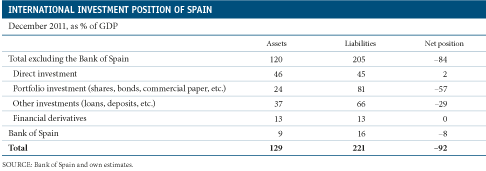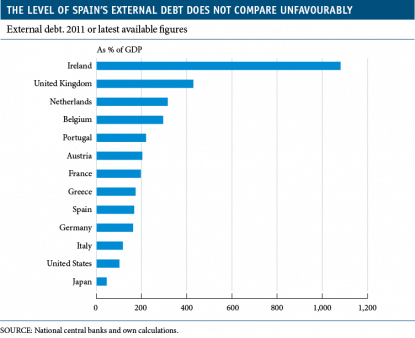Is Spain's external position sustainable?
Since the euro was adopted, Spain has accumulated 666 billion euros in external deficits. In fact, we have to go back to the mid-1980s to find the last trace of a surplus. Inevitably, these deficits have been financed with foreign capital, causing a considerable increase in liabilities vis-à-vis the rest of the world, mostly in the form of debt. This external position currently constitutes one of the key vulnerabilities of the Spanish economy as it raises doubts regarding the country's solvency and also requires constant access to international financing markets.
At the end of 2011, Spain's net international investment position (NIIP) reached a net negative balance equivalent to 92% of GDP. This position combines foreign assets equivalent to 129% of GDP and liabilities of 221% of GDP (see the table below). This figure could be worrying for various reasons: it is one of the highest debtor positions in the world, only surpassed in the euro area by Ireland and Portugal, so we must wonder whether Spain can afford it; a high proportion of the total liabilities are in the form of debt and this, as it requires regular payments for interest and amortization, entails greater vulnerability than other kinds of liabilities, such as shares and other forms of participation in corporate capital; and, lastly, the net liability position has tripled since the euro was adopted, which might suggest that an explosive dynamic is at work. However, all these concerns can be qualified.
Firstly, although the NIIP is relatively high, the cost of financing it is relatively modest. The income account of the balance of payments, which mostly reflects net payments for interest and dividends, only had a deficit equivalent to 2.4% of GDP in 2011, a figure similar to the average for the previous five years. The average cost on liabilities was limited to 2.9% thanks to low official interest rates, which affect the short-term rates to which a significant proportion of external debt is indexed, and also thanks to the moderation in dividend payments. Moreover, the impact of the higher risk premium was limited as the pass-through to the average cost is very gradual (the pace is determined mainly by the proportion of debt that matures and is refinanced). For their part, external assets received an average yield of 3.0%, slightly more than that of liabilities, thanks to the earnings of Spanish multinationals.
Secondly, although it's true that three quarters of all liabilities are in the form of debt, Spain's level of external debt, equivalent to 165% of GDP, does not compare unfavourably with other European countries (see the graph below). In particular, the external debt of public administrations (26% of GDP) is one of the lowest in the euro area. Private external debt (139% of GDP) is comparatively higher but its share in GDP is similar to that of France and Austria and lower than that of Portugal and other countries where the financial system involves considerable international activity (United Kingdom, Ireland, Belgium, Netherlands).
Lastly, the net investment position seems to have stabilized over the last few years. Since 2009, net liabilities have remained at around 90% of GDP while external debt has fluctuated around 165% of GDP. This has been mainly the result of the sharp adjustment in the trade deficit, which declined from 6.5% of GDP in 2007 to 0.5% of GDP in 2011 (allowing the current account deficit to fall from 10.0% of GDP to 3.5% of GDP, see the box «Target surplus: reality or mirage?» on page 17). However, the effects of revaluing assets and liabilities have also played a significant part. In particular, the relatively greater losses in the Spanish stock exchange and the higher risk premium have reduced the market value of liabilities vis-à-vis non-residents, helping to contain the increase in net liabilities.
Given that we can't expect revaluation effects to help to sustain the level of liabilities year after year, the external deficit will have to continue its adjustment to ensure the long-term stabilization and, even better, the reduction of the net debt position of Spain. The adjustment required will largely depend on the interest rate paid by Spain for its external debt.(1) For example, in a scenario where the average yield demanded for net liabilities increases to 4.0% (as a consequence, for example, of a continually high risk premium) and if the nominal growth in GDP were 3.0% (a conservative assumption if we take into account the potential growth of the Spanish economy in the medium term), a trade surplus of 0.9% of GDP would be required to stabilize the net debt position at 90% of GDP. This requirement is not a tall order as, for 2012, we are already predicting that the trade surplus will come close to this figure. However, to reduce the net debt position to 70% of GDP within 10 years, we would have to post a trade surplus of practically 3% of GDP every year. Therefore, the correction undertaken by the trade balance in the last few years must continue, also taking into account the fact that the larger the differential between the interest rate paid for external debt and the economy's rate of growth, the greater the trade surplus required to stabilize or reduce external debt.
The dynamics of the investment position, virtually stabilized, and the cost of servicing the debt, which Spain can bear if the risk premium doesn't increase further, suggest that the main problem of Spain's external position is more related to issues of liquidity than solvency. But liquidity and solvency are very closely connected concepts: a liquidity crisis that pushes up risk premia and forces rapid deleveraging limits the ability to refinance debt and thereby raises doubts regarding the debtor's solvency; on the other hand, within an environment of widespread risk aversion as the present, a few doubts regarding the solvency of a debtor could lead to a liquidity crisis.
Investor expectations need to be turned around in order to break the vicious circle between problems of liquidity and doubts regarding solvency, and this can only be achieved by acting simultaneously on both fronts. Acting on the liquidity front involves someone exercising the role of lender of last resort, with the capacity to inject liquidity into financial institutions and acquire public debt. This must necessarily be complemented by actions that dispel doubts regarding the solvency of the country's public and private sectors and, in this respect, the key lies in: making the deficit reduction targets more credible; speeding up the clean-up and restructuring of the financial system; and continuing to improve the competitiveness of our economy. Although it's true that the progress made in strengthening both fronts –liquidity and solvency– has been substantial, there's undoubtedly still a long way to go.
(1) The equation that describes the dynamic of the external debt position is: , where d represents the debt position as a percentage of GDP (within the period given by the subindex); i refers to the average yield to be paid; g is the nominal growth in GDP; and p is the trade balance for goods and services plus net current and capital transfers. In Spain, p was equivalent to –0.6% of GDP in 2011 (basically coinciding with the trade balance for goods and services as the surplus in capital transfers was practically wiped out by the deficit in current transfers; consequently, in the text we refer to p as the trade balance).
dt = | (1+i) | dt -1 – pt |
(1+g) |
This box was prepared by Enric Fernández
International Unit, Research Department, "la Caixa"


